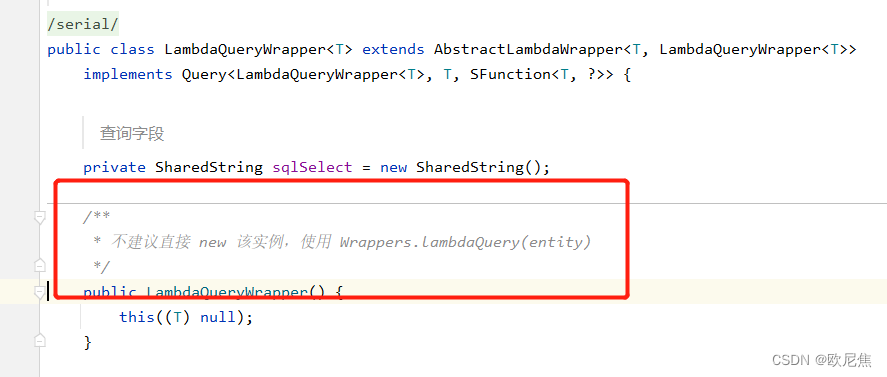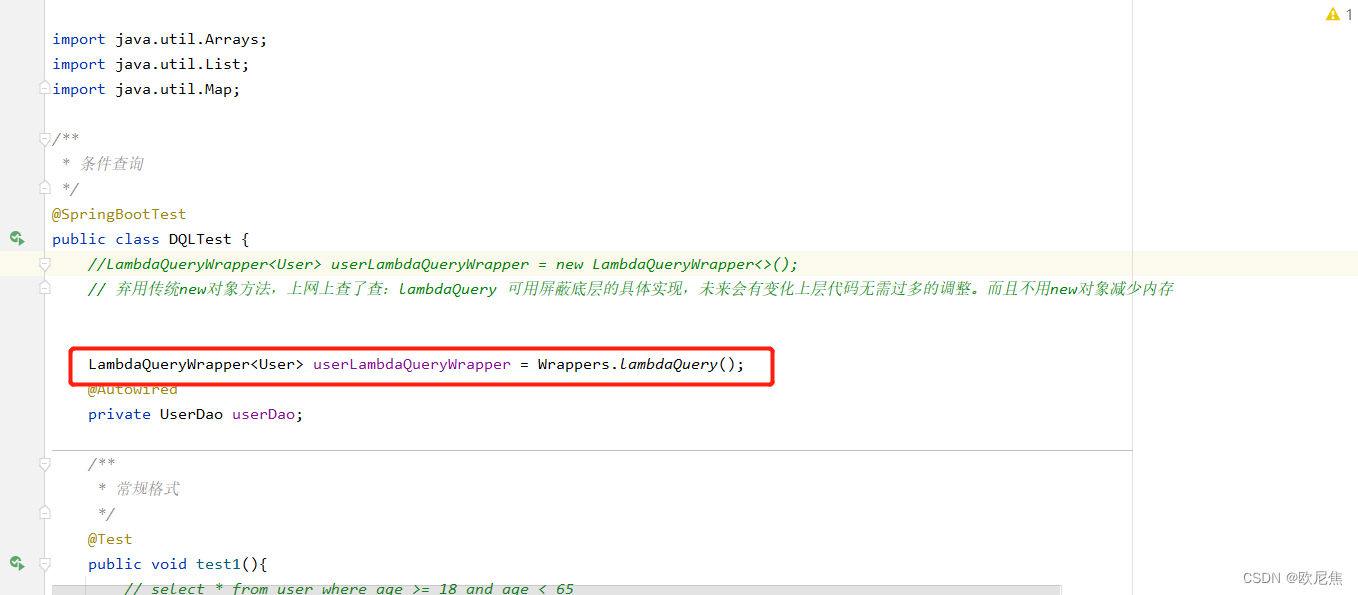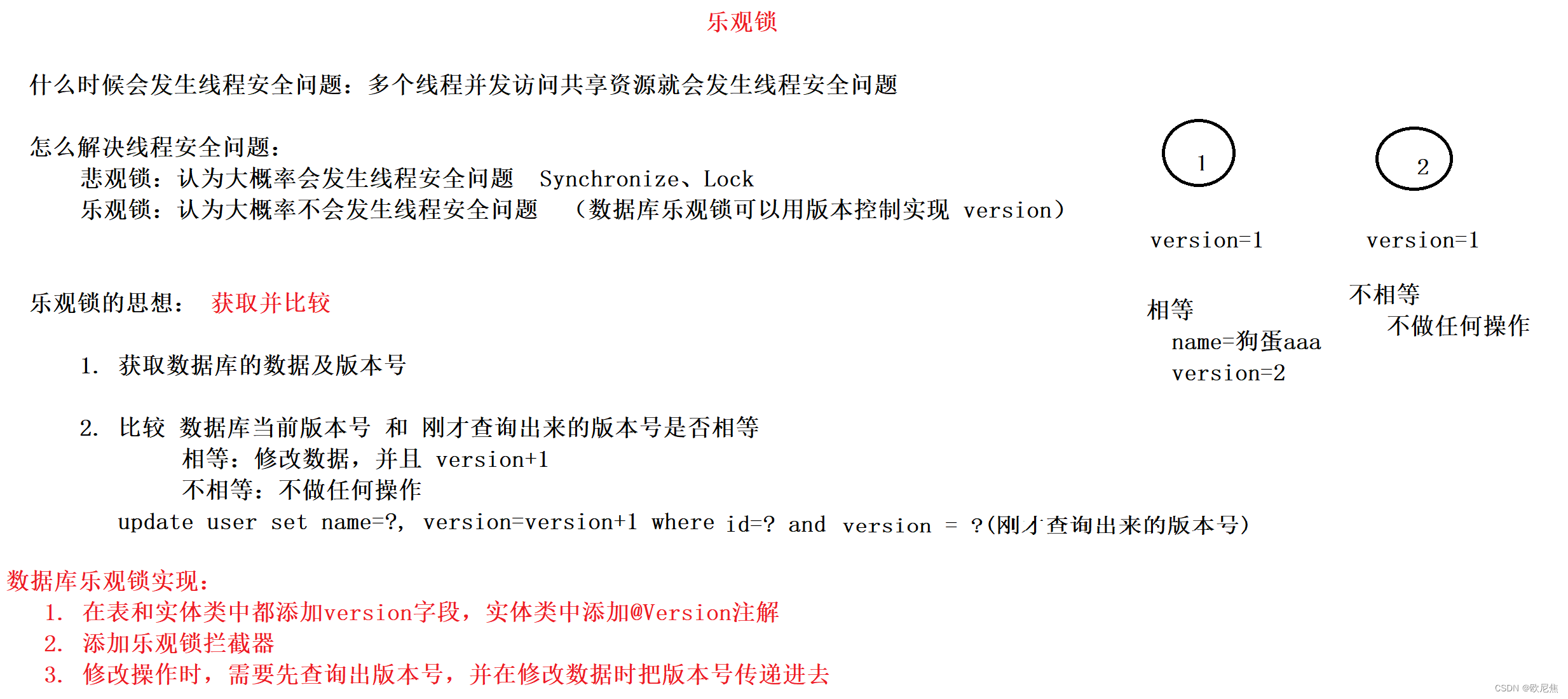MyBatisPlus Study Notes
创始人
2024-05-27 16:07:11
0次
文章目录
- 1 MyBatisPlus概述
- 1.1 MyBatis介绍
- 1.2 MyBatisPlus特性
- 2 标准数据层开发
- 2.1 MyBatisPlus的CRUD操作API
- 2.2 分页功能接口实现
- 2.2.1 config(配置层)拦截器实现
- 2.2.2 Dao(Mapper)数据访问层(CRUD)操作
- 2.2.3 Junit单元测试进行测试
- 2.3 开启MyBatisPlus日志
- 2.4 取消初始化spring日志打印
- 2.5 取消SpringBoot启动banner图标、关闭mybatisplus启动图标
- 3 MyBatisPlus DQL
- 3.1 条件查询API
- 3.2 条件查询
- 3.2.1 方式一:按条件查询(常规格式)
- 3.2.2 方式二:按条件查询(lambda格式)
- 3.3 MyBatisPlus中null值判断
- 3.4 批量(Batch)操作
- 3.5 查询投影(聚合查询)【查询字段、分组、分页】
- 3.6 字段映射与表名映射
- 4 DML编程控制
- 4.1 id生成策略控制(Insert)
- 4.2 逻辑删除(Delete/Update)
- 4.2.1 数据库表中添加逻辑删除字段
- 4.2.2 实体类中添加对应字段,并设定当前字段为逻辑删除标记字段
- 5 乐观锁(Update)
1 MyBatisPlus概述
1.1 MyBatis介绍
- MyBatisPlus(简称MP)基于MyBatis框架基础上开发的增强型工具,旨在简化开发、提高效率
- MyBatisPlus官网
1.2 MyBatisPlus特性
- 无侵入:只做增强不做改变,不会对现有工程产生影响
- 强大的 CRUD 操作:内置通用 Mapper,少量配置即可实现单表CRUD 操作
- 支持 Lambda:编写查询条件无需担心字段写错
- 支持主键自动生成
- 内置分页插件
- ……
2 标准数据层开发
2.1 MyBatisPlus的CRUD操作API
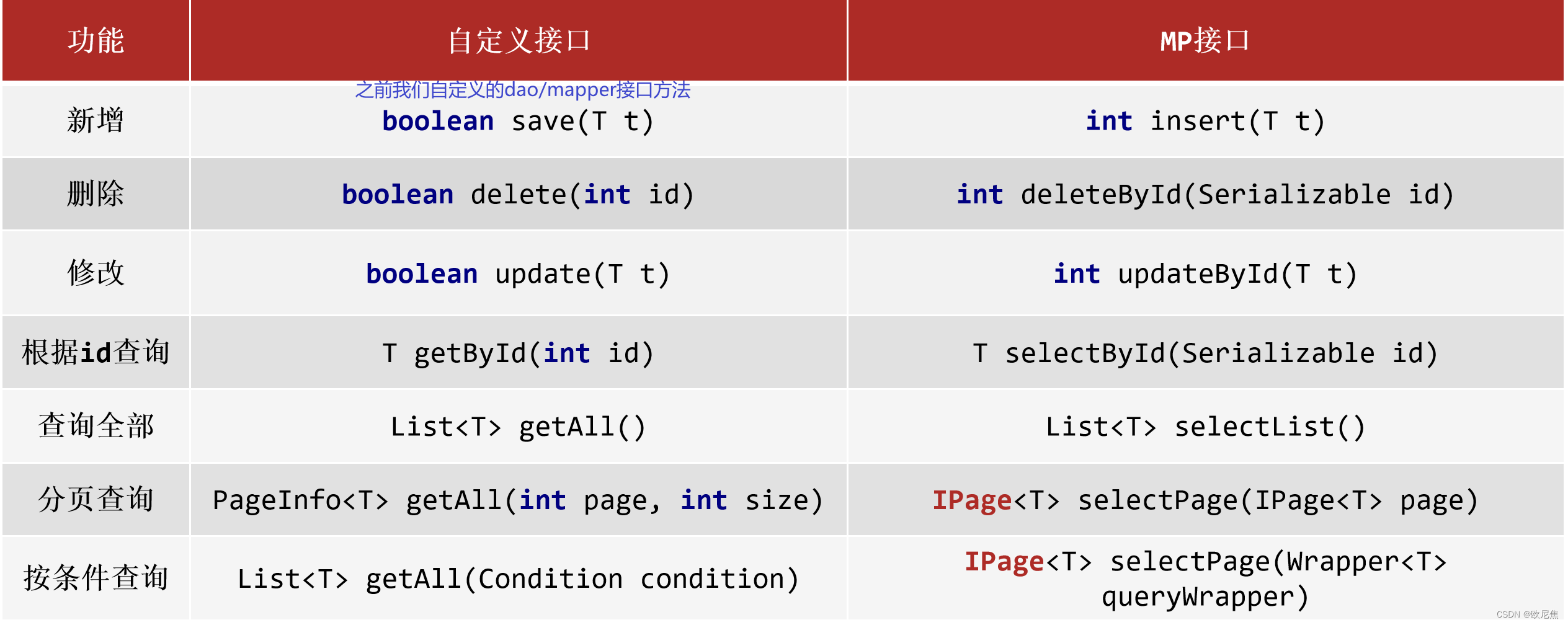
2.2 分页功能接口实现
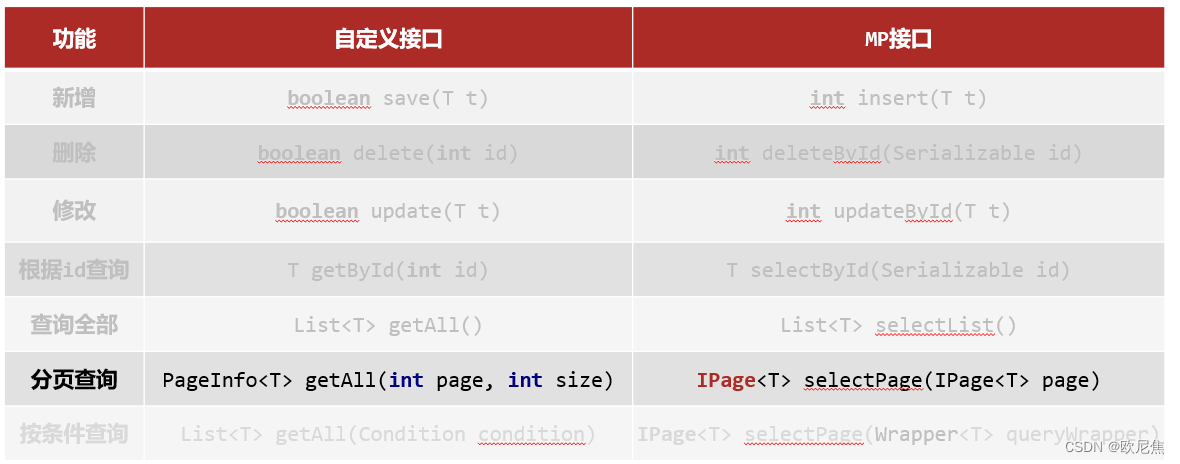
2.2.1 config(配置层)拦截器实现
此处拦截SQL语句,目的是为了拼接,分页条件
@Configuration
public class MpConfig {@Beanpublic MybatisPlusInterceptor mpInterceptor(){//1.定义Mp拦截器 ,创建MybatisPlusInterceptor拦截器对象MybatisPlusInterceptor mpInterceptor = new MybatisPlusInterceptor();//2.添加具体的拦截器、添加分页拦截器mpInterceptor.addInnerInterceptor(new PaginationInnerInterceptor());return mpInterceptor;}
}
2.2.2 Dao(Mapper)数据访问层(CRUD)操作
实现BaseMapper<>接口
@Mapper
public interface UserDao extends BaseMapper {
}
2.2.3 Junit单元测试进行测试
@Testpublic void testPage() {IPage page = new Page(2, 5);// 分页构造器:设置 当前第几页 一页多少条IPage pageResult = userDao.selectPage(page, null);System.out.println(JSON.toJSONString(page));System.out.println("数据列表" + JSON.toJSONString(pageResult.getRecords()));System.out.println("当前页码" + pageResult.getCurrent());System.out.println("每页条数" + pageResult.getSize());System.out.println("总记录数" + pageResult.getTotal());System.out.println("总页数" + pageResult.getPages());}
}
2.3 开启MyBatisPlus日志
# 开启mp的日志(输出到控制台)
mybatis-plus:configuration:log-impl: org.apache.ibatis.logging.stdout.StdOutImpl
2.4 取消初始化spring日志打印
做法:在resources下新建ogback.xml文件,内容如下:
2.5 取消SpringBoot启动banner图标、关闭mybatisplus启动图标
spring:main:banner-mode: off # 关闭SpringBoot启动图标(banner)
# mybatis-plus日志控制台输出
mybatis-plus:configuration:log-impl: org.apache.ibatis.logging.stdout.StdOutImplglobal-config:banner: off # 关闭mybatisplus启动图标
3 MyBatisPlus DQL
3.1 条件查询API
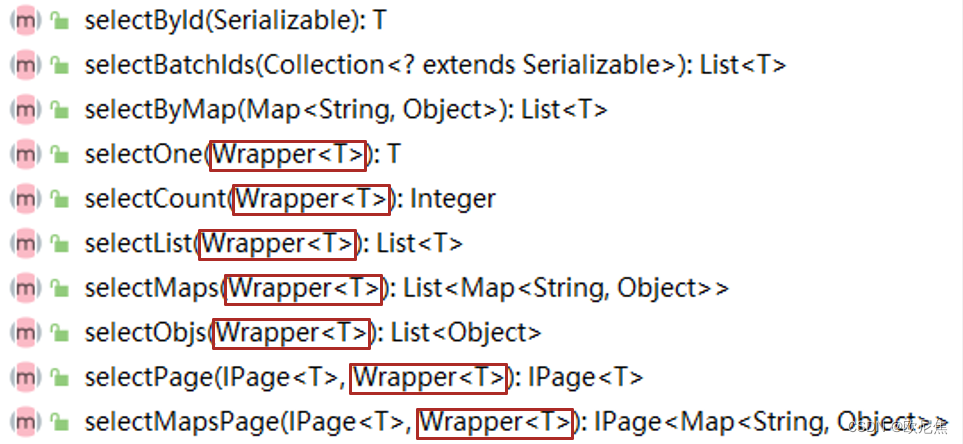
3.2 条件查询
3.2.1 方式一:按条件查询(常规格式)
//方式一:按条件查询@Testpublic void test1(){// select * from user where age >= 18 and age < 65QueryWrapper qw = new QueryWrapper<>();qw.ge("age",18);qw.lt("age",65);List userList = userDao.selectList(qw);System.out.println(JSON.toJSONString(userList)); //[{"age":28,"id":5,"name":"snake","password":"123456","tel":"12345678910"},{"age":22,"id":6,"name":"张益达","password":"123456","tel":"12345678910"}]/*System.out.println(userList);不进行JSON转换输出[User(id=5, name=snake, password=123456, age=28, tel=12345678910), User(id=6, name=张益达, password=123456, age=22, tel=12345678910)]* */}
3.2.2 方式二:按条件查询(lambda格式)
查阅源码优化全局变量处声明对象操作
3.2.2.1全局变量声明
LambdaQueryWrapper userLambdaQueryWrapper = Wrappers.lambdaQuery();//lambdaQuery 可用屏蔽底层的具体实现,未来会有变化上层代码无需过多的调整。而且不用new对象减少内存@Autowiredprivate UserDao userDao;
3.2.2.2 select * from user where age >= 18 and age < 65
| 传统语法 | MyBatisPlus语法 | 说明 |
|---|---|---|
| < | lt | less than |
| <= | le | less equal |
| > | gt | greater than |
| >= | ge | greater equal |
| = | eq | equal |
| between and | 范围 | |
| like | 模糊查询 | |
| in | 在in之后的列表中的值,多选一 |
//lambda格式@Testpublic void test2(){// select * from user where age >= 18 and age < 65//LambdaQueryWrapper userLambdaQueryWrapper1 = new LambdaQueryWrapper<>();// LambdaQueryWrapper userLambdaQueryWrapper = Wrappers.lambdaQuery();userLambdaQueryWrapper.ge(User::getAge,18).lt(User::getAge,65);List userList = userDao.selectList(userLambdaQueryWrapper);System.out.println(JSON.toJSONString(userList));System.out.println("=================");System.out.println(userList);}
// 等于@Testpublic void test3(){//select * from user where name = "tom"userLambdaQueryWrapper.eq(User::getName,"tom");List userList = userDao.selectList(userLambdaQueryWrapper);System.out.println(JSON.toJSONString(userList));} 3.3 MyBatisPlus中null值判断
/*** null值判断* 判断 字段值是否为null 不为null才拼接查询条件*/@Testpublic void test31(){//模拟前端传的参数//select * from user where name = nullUser user = new User();/* if (user.getName()!=null){userLambdaQueryWrapper.eq(User::getName,user.getName());}健壮性判断*/userLambdaQueryWrapper.eq(user.getName()!= null,User::getName,user.getName());//此处user.getName()为空,User::getName与user.getName()作对比,// 即 在数据库实体类中的name属性="null" 做判断条件List userList = userDao.selectList(userLambdaQueryWrapper);System.out.println(JSON.toJSONString(userList));} // like模糊查询@Testpublic void test4(){//select * from user where name like "j%"userLambdaQueryWrapper.like(User::getName,"j");List list = userDao.selectList(userLambdaQueryWrapper);System.out.println(list);}
/*** between*/@Testpublic void test5(){//select * from user where age between 16 and 28userLambdaQueryWrapper.between(User::getAge, 16, 28);List list = userDao.selectList(userLambdaQueryWrapper);System.out.println(list);}
/*** in*/@Testpublic void test6(){//select * from user where id in (1,2,3)List inList = Arrays.asList(1, 2, 3);userLambdaQueryWrapper.in(User::getId, inList);List list = userDao.selectList(userLambdaQueryWrapper);System.out.println(list);}
3.4 批量(Batch)操作
/*** 根据id列表批量查询*/@Testpublic void test1(){List ids = Arrays.asList(1, 2, 3);//将一个变长参数或者数组转换成ListList userList = userDao.selectBatchIds(ids);System.out.println(userList);}
/*** 根据id列表批量删除*/@Testpublic void test2(){List ids = Arrays.asList(1, 2, 3);int count = userDao.deleteBatchIds(ids);System.out.println(count);}
3.5 查询投影(聚合查询)【查询字段、分组、分页】
/*** 聚合查询一般用: selectMaps*/@Testpublic void test(){//select tel, count(*) as cnt from user group by tel order by cnt;QueryWrapper userQueryWrapper = new QueryWrapper<>();userQueryWrapper.select("tel","count(*) as cnt");userQueryWrapper.groupBy("tel");userQueryWrapper.orderByAsc("cnt");List> mapList = userDao.selectMaps(userQueryWrapper); //selectMaps:根据 Wrapper 条件,查询全部记录System.out.println(JSON.toJSONString(mapList));}
3.6 字段映射与表名映射
| 注解 | 说明 |
|---|---|
| @TableField | 通过value属性(value="数据库中实际字段名"),设置当前属性对应的数据库表中的字段关系 |
| @TableField | 通过exist属性(true存在;false不存在),设置属性在数据库表字段中是否存在,默认为true。不能与value合并使用 |
| @TableField | 通过select属性(true参与;false不参与):设置该属性是否参与查询。此属性与select()映射配置不冲突。 |
| @TableName | 通过value属性@TableName("数据库中实际表名"),设置当前类对应的数据库表名称 |
4 DML编程控制
4.1 id生成策略控制(Insert)
| 注解 | 说明 |
|---|---|
| @TableId | 1、AUTO(0): 使用数据库id自增策略控制id生成;2、NONE(1):不设置id生成策略;3、INPUT(2):用户手工输入id;4、ASSIGN_ID(3):雪花算法生成id (可兼容数值型与字符串型);5、ASSIGN UUID(4):以UUID生成算法作为id生成策略 |
4.1.1 全局配置
mybatis-plus:global-config:db-config:id-type: assign_idtable-prefix: tbl_
4.2 逻辑删除(Delete/Update)
4.2.1 数据库表中添加逻辑删除字段

4.2.2 实体类中添加对应字段,并设定当前字段为逻辑删除标记字段
package com.itheima.domain;import com.baomidou.mybatisplus.annotation.*;import lombok.Data;@Data
public class User {private Long id;//逻辑删除字段,标记当前记录是否被删除@TableLogicprivate Integer deleted;}
4.2.2.1 全局配置逻辑删除字面值(不建议)
mybatis-plus:global-config:db-config:table-prefix: tbl_# 逻辑删除字段名logic-delete-field: deleted# 逻辑删除字面值:未删除为0logic-not-delete-value: 0# 逻辑删除字面值:删除为1logic-delete-value: 1
5 乐观锁(Update)
乐观锁的解决思想:
首先,在多个线程访问共享资源(数据库)时,给数据库添加一个version(int)的标记字段,然后,当某一个线程首先获取到数据库中资源是,version发生改变(常规操作自动加一),
相关内容
热门资讯
安卓9系统怎样应用分身,轻松实...
你有没有发现,手机里的APP越来越多,有时候一个APP里还要处理好多任务,分身功能简直就是救星啊!今...
获取安卓系统的ip地址,轻松获...
你有没有想过,你的安卓手机里隐藏着一个神秘的IP地址?没错,就是那个能让你在网络世界里找到自己的小秘...
LG彩电安卓系统升级,畅享智能...
你家的LG彩电是不是最近有点儿“闹别扭”,屏幕上时不时地跳出个升级提示?别急,今天就来给你详细说说这...
阴阳师安卓苹果系统,安卓与苹果...
亲爱的玩家们,你是否曾在深夜里,手握手机,沉浸在阴阳师的神秘世界?今天,就让我带你一起探索这款风靡全...
华为安卓系统区别在哪,独特创新...
你知道吗?最近手机圈里可是热闹非凡,尤其是华为的新动作,让很多人眼睛都瞪大了。没错,我说的就是华为自...
怎么重新刷安卓手机系统,深度解...
手机用久了,是不是感觉卡顿得厉害?别急,今天就来教你怎么重新刷安卓手机系统,让你的手机焕然一新,速度...
刷正版安卓系统教程,刷正版安卓...
你有没有想过,让你的安卓手机焕然一新,体验一把正版系统的魅力呢?别急,今天就来手把手教你如何刷正版安...
移动支撑系统安卓版,助力移动办...
你有没有发现,现在的生活越来越离不开手机了?无论是工作还是娱乐,手机几乎成了我们生活的必需品。而今天...
安卓怎么进win系统界面,安卓...
亲爱的安卓用户,你是否曾幻想过在安卓设备上直接体验Windows系统的魅力?别再羡慕那些Window...
incall可以升级安卓系统吗...
你有没有想过,你的手机是不是也能像电脑一样,时不时地来个系统升级呢?今天,咱们就来聊聊这个话题——i...
安卓系统带农历软件,尽享传统节...
你知道吗?现在智能手机上有个特别实用的功能,那就是农历显示。对于咱们中国人来说,农历可是有着深厚的历...
安卓系统资源占用高,揭秘原因与...
你有没有发现,你的安卓手机最近变得越来越慢了?是不是觉得打开一个应用都要等半天,甚至有时候还会卡死?...
安卓10的系统有哪些,功能升级...
你有没有发现,你的安卓手机最近是不是变得有点不一样了?没错,就是那个神秘的安卓10系统!它就像一位魔...
固态硬盘系统迁移到安卓,固态硬...
你有没有想过,把你的固态硬盘系统迁移到安卓设备上,是不是能让你在移动办公或者娱乐时更加得心应手呢?想...
平板电脑能玩安卓系统吗,畅享丰...
你有没有想过,平板电脑竟然也能玩安卓系统?这可不是天方夜谭,而是科技发展的新趋势。想象你手中的平板瞬...
安卓刷精简系统下载,轻松打造高...
你有没有想过,你的安卓手机是不是有点儿“臃肿”了呢?运行速度慢,电池续航短,有时候还卡得要命。别急,...
安卓子系统windows11,...
你知道吗?最近科技圈可是炸开了锅,因为安卓子系统在Windows 11上的兼容性成了大家热议的话题。...
电脑里怎么下载安卓系统,电脑端...
你有没有想过,你的电脑里也能装上安卓系统呢?没错,就是那个让你手机不离手的安卓!今天,就让我来带你一...
索尼相机魔改安卓系统,魔改系统...
你知道吗?最近在摄影圈里掀起了一股热潮,那就是索尼相机魔改安卓系统。这可不是一般的改装,而是让这些专...
安卓系统哪家的最流畅,安卓系统...
你有没有想过,为什么你的手机有时候像蜗牛一样慢吞吞的,而别人的手机却能像风一样快?这背后,其实就是安...

